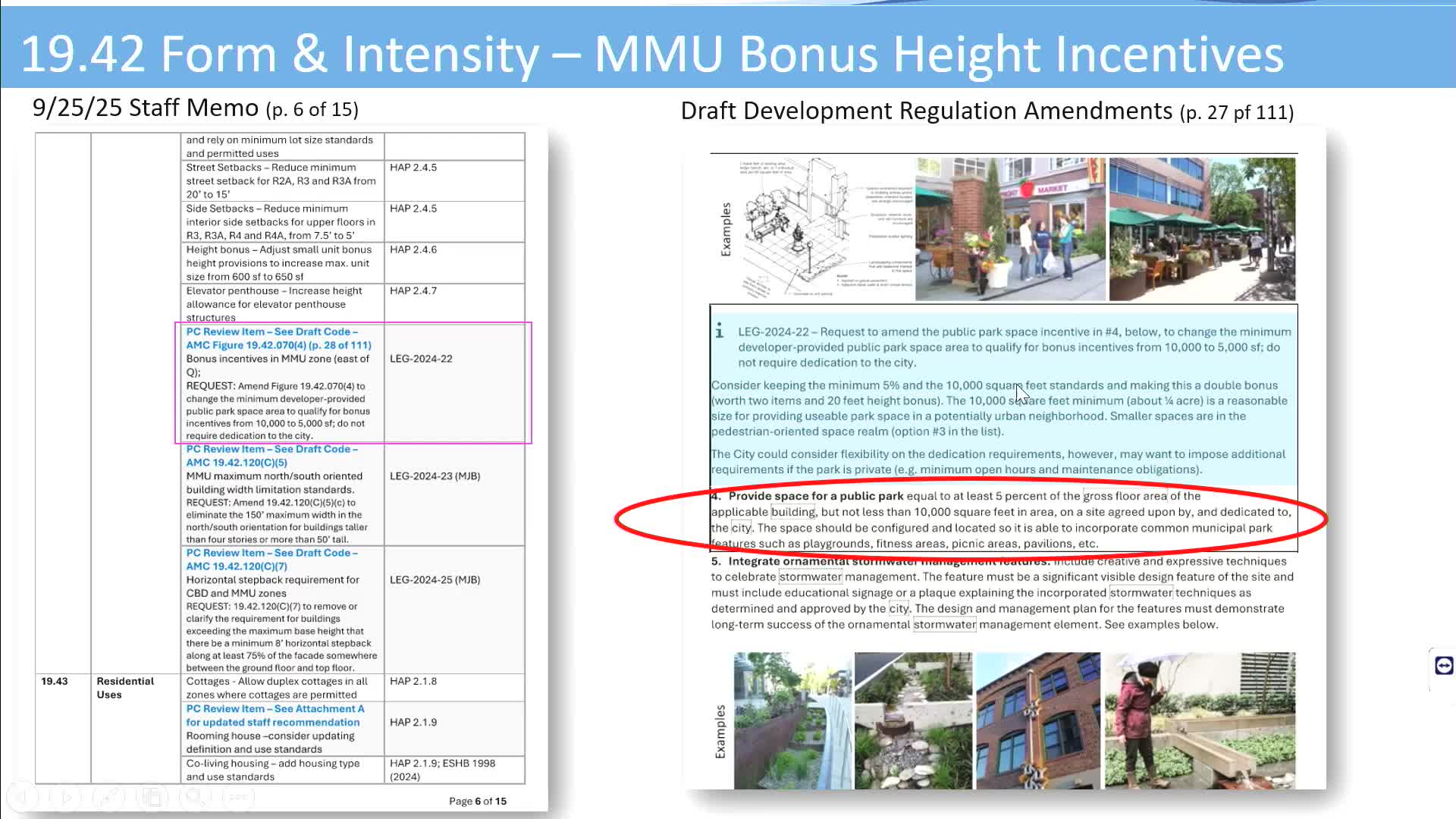Kirkland Planning Commission Reviews Open Space Bonus Incentives for Residential Development
October 02, 2025 | Anacortes, Skagit County, Washington
This article was created by AI summarizing key points discussed. AI makes mistakes, so for full details and context, please refer to the video of the full meeting. Please report any errors so we can fix them. Report an error »

In the heart of Anacortes, city planners gathered under the bright lights of the municipal building to discuss a pivotal proposal that could reshape the community's landscape. The Planning Commission meeting on October 1, 2025, focused on a new incentive aimed at enhancing public park space within urban developments.
At the center of the discussion was a proposed minimum requirement of 10,000 square feet for public park areas in new developments. This benchmark, emphasized by city staff, is intended to ensure that parks are not merely pedestrian plazas but genuine green spaces that can be enjoyed by the community. The proposal aims to strike a balance between development and the need for accessible public areas, fostering a sense of community in the growing urban environment.
Commission members deliberated on the flexibility of park space dedication to the city. While some expressed concerns about the city taking on maintenance responsibilities, others suggested that developers could retain ownership while still providing public access. This approach could alleviate the burden on city resources while ensuring that parks remain well-maintained and accessible to residents.
Jimmy Blaze, representing MJB Properties, voiced support for the proposed changes, highlighting the need for equitable development standards. He pointed out that the current requirements could lead to impractical situations, where a massive building would be necessary to meet the existing open space ratios. By aligning the park space requirement with realistic development sizes, the city could encourage more thoughtful and sustainable growth.
The conversation also touched on the potential for mixed-use developments, where up to 60% of a site could be dedicated to residential use, leaving room for various other commercial opportunities. This flexibility could lead to vibrant neighborhoods that blend living, working, and recreational spaces.
As the meeting progressed, the commission members largely agreed on the importance of maintaining public access to these park areas, even if they are not dedicated to the city. The consensus was clear: while the city should not be burdened with ownership and maintenance, it is crucial that these spaces serve the community effectively.
In conclusion, the Planning Commission's discussions signal a thoughtful approach to urban development in Anacortes. By prioritizing public park space while allowing for developer flexibility, the city aims to create a balanced environment that meets the needs of its growing population. As the proposal moves forward, the community will be watching closely to see how these plans unfold and shape the future of Anacortes.
At the center of the discussion was a proposed minimum requirement of 10,000 square feet for public park areas in new developments. This benchmark, emphasized by city staff, is intended to ensure that parks are not merely pedestrian plazas but genuine green spaces that can be enjoyed by the community. The proposal aims to strike a balance between development and the need for accessible public areas, fostering a sense of community in the growing urban environment.
Commission members deliberated on the flexibility of park space dedication to the city. While some expressed concerns about the city taking on maintenance responsibilities, others suggested that developers could retain ownership while still providing public access. This approach could alleviate the burden on city resources while ensuring that parks remain well-maintained and accessible to residents.
Jimmy Blaze, representing MJB Properties, voiced support for the proposed changes, highlighting the need for equitable development standards. He pointed out that the current requirements could lead to impractical situations, where a massive building would be necessary to meet the existing open space ratios. By aligning the park space requirement with realistic development sizes, the city could encourage more thoughtful and sustainable growth.
The conversation also touched on the potential for mixed-use developments, where up to 60% of a site could be dedicated to residential use, leaving room for various other commercial opportunities. This flexibility could lead to vibrant neighborhoods that blend living, working, and recreational spaces.
As the meeting progressed, the commission members largely agreed on the importance of maintaining public access to these park areas, even if they are not dedicated to the city. The consensus was clear: while the city should not be burdened with ownership and maintenance, it is crucial that these spaces serve the community effectively.
In conclusion, the Planning Commission's discussions signal a thoughtful approach to urban development in Anacortes. By prioritizing public park space while allowing for developer flexibility, the city aims to create a balanced environment that meets the needs of its growing population. As the proposal moves forward, the community will be watching closely to see how these plans unfold and shape the future of Anacortes.
View full meeting
This article is based on a recent meeting—watch the full video and explore the complete transcript for deeper insights into the discussion.
View full meeting
